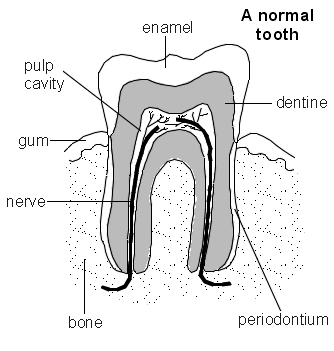|
What is a dental abscess?

Periapical abscess
This type of abscess starts in the dental pulp (centre of the tooth). This is the most common type. This type of abscess usually develops as a complication of tooth decay (caries). Dental decay is very common and erodes (damages and breaks down) the protective layers of the tooth (the enamel and dentine). The damage to the tooth allows bacteria to invade the pulp to cause an infection.
An infection in the pulp can progress to form an abscess. Sometimes a periapical abscess develops if the nerve to the tooth dies for any reason. For example, from injury. The dead tissue inside a tooth is more prone to infection.
Periodontal abscess
This type of abscess starts in the supporting structures of the teeth, such as the periodontium which is between the tooth and the gum. It most commonly develops as a complication of gum disease (periodontal disease), which is infection or inflammation of the tissues that surround the teeth. Gum disease often causes the gum to become slightly detached from the tooth. This causes pockets to form which may get filled with bacteria and progress to form an abscess. A periodontal abscess may also develop as a complication of injury to the gums or periodontium. A periodontal abscess is sometimes called a gum boil as the abscess causes a swelling to develop next to a tooth.
What are the symptoms of a dental abscess?
Symptoms typically include one or more of the following:
- Pain (toothache) which can quickly become worse. It can be severe and throbbing.
- Swelling of the gum which can be tender.
- Swelling of the face. The skin over an abscess may become red and inflamed.
- The affected tooth may become tender to touch, and may even become loose.
- High temperature (fever) and feeling generally unwell.
- In severe cases, there may be spasm of the jaw muscles.
What is the treatment of a dental abscess?
Initial treatment
See a dentist as soon as possible. A dentist will normally drain the pus and this often gives great relief of symptoms. This is done either by lancing the abscess or by drilling a small hole in the tooth to let the pus escape. Sometimes, if the infection is not contained, an antibiotic is prescribed for a few days after draining the pus to clear any remaining infection. However, in most cases an antibiotic is probably not needed once the pus is drained.
If there is a delay in seeing a dentist, a doctor may prescribe an antibiotic to help prevent the abscess from getting worse or spreading. However, an antibiotic will not clear the pus and cure the abscess. You still need to see a dentist soon. You may also need painkillers such as paracetamol or ibuprofen until the abscess is drained and treated. Note: paracetamol and ibuprofen can be taken together if pain relief with either alone is not enough. Some people require stronger painkillers prescribed by a doctor.
Further treatment may include the following:
For a periapical abscess
The treatment for this type of abscess is normally root canal treatment. This treatment aims to save and restore the damaged or dead inner part of a tooth (the pulp). Briefly - your dentist will drill into the dead tooth and allow pus to escape through the tooth, and then remove the dead pulpal tissue. A root filling is then placed into the tooth to fill the space and prevent further infection. (Note: even if pain has gone with an initial emergency drainage of the pus, you are still likely to need root canal treatment. This is because the infection and abscess will almost certainly return unless the dead pulp tissue is dealt with.)
If the infection persists despite root canal treatment, the dentist may have to extract (remove) the tooth.
For a periodontal abscess
Once the pus is drained, a dentist may clean the pocket where the abscess had formed. Following this a dentist may smooth out the root surfaces of the tooth to encourage the gum to close back on to the tooth, and for any pocket to disappear. This helps to prevent a recurrence of infection. If you develop repeated periodontal abscesses you may need a surgical procedure to reshape the gum tissue.
What is the outlook (prognosis)?
If treated, the outlook is good. The pus can usually be drained and the tooth can be saved if it is not badly broken down. If left untreated, the abscess may burst on to the skin of the face, or into the mouth. This may leave a sinus tract (a channel) between a persistent focus of infection and the skin or mouth, which can discharge pus from time to time. Other complications are uncommon. However, they can be serious, even fatal in rare situations. They include:
- Osteomyelitis - an infection of the nearby bone.
- Sinusitis - spread of infection to the nearby sinus in the face bone.
- A dental cyst (fluid-filled cavity) which may develop.
- Cavernous sinus thrombosis - an infection and clotting of a blood vessel in the brain. This is very serious.
- A serious, potentially life-threatening infection of the floor of the mouth. This could spread to the face, brain or neck
Can a dental abscess be prevented?
Most dental abscesses are preventable as most are a complication of tooth decay or gum disease - both of which can be prevented by good oral hygiene. Briefly, this means regular tooth brushing and flossing. Other things that may help include: mouthwashes, tongue cleaning, and eating a healthy diet, which includes limiting sugary drinks and foods. If you smoke, stopping smoking will improve oral hygiene. Have a dental check-up every 6 months.
| 

